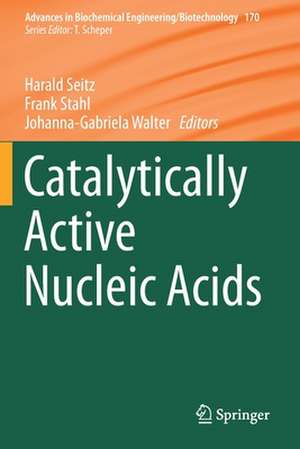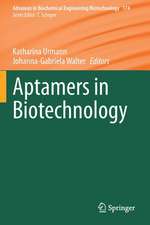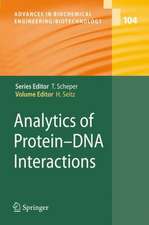Catalytically Active Nucleic Acids: Advances in Biochemical Engineering/Biotechnology, cartea 170
Editat de Harald Seitz, Frank Stahl, Johanna-Gabriela Walteren Limba Engleză Paperback – 12 oct 2020
After the discovery of natural ribozymes – RNA molecules that mediate the cleavage and formation of phosphodiester bonds and the formation of peptide bonds – numerous artificial ribozymes with altered catalytic activities were produced by in vitro and in vivo selection. Unlike ribozymes, DNAzymes do not occur in nature. Although the catalytic activity of nucleic acid enzymes is usually much slower than that of proteins, nucleic acid enzymes with comparable catalytic activity have been obtained using stringent selection processes. The key advantages of these enzymes: they are e.g. smaller, easier to produce and purify than proteins, and can withstand denaturation, e.g. by heat.
Over the last few years, the number of publications on the applications of enzymatic nucleic acids has grown steadily. Summarizing the fundamentals and applications of these acids, this book will not only be an excellent resource for experts in the field but will also guide young researchers just starting out in this significant area.
| Toate formatele și edițiile | Preț | Express |
|---|---|---|
| Paperback (1) | 1644.71 lei 6-8 săpt. | |
| Springer International Publishing – 12 oct 2020 | 1644.71 lei 6-8 săpt. | |
| Hardback (1) | 1650.56 lei 6-8 săpt. | |
| Springer International Publishing – 11 oct 2019 | 1650.56 lei 6-8 săpt. |
Din seria Advances in Biochemical Engineering/Biotechnology
-
 Preț: 385.84 lei
Preț: 385.84 lei -
 Preț: 383.12 lei
Preț: 383.12 lei -
 Preț: 383.71 lei
Preț: 383.71 lei - 18%
 Preț: 1220.45 lei
Preț: 1220.45 lei - 18%
 Preț: 1816.43 lei
Preț: 1816.43 lei - 5%
 Preț: 1415.54 lei
Preț: 1415.54 lei - 5%
 Preț: 2113.74 lei
Preț: 2113.74 lei - 18%
 Preț: 1219.16 lei
Preț: 1219.16 lei - 18%
 Preț: 1823.56 lei
Preț: 1823.56 lei - 18%
 Preț: 1219.63 lei
Preț: 1219.63 lei - 18%
 Preț: 1224.18 lei
Preț: 1224.18 lei - 18%
 Preț: 1826.07 lei
Preț: 1826.07 lei - 18%
 Preț: 1836.31 lei
Preț: 1836.31 lei -
 Preț: 383.71 lei
Preț: 383.71 lei - 18%
 Preț: 1821.81 lei
Preț: 1821.81 lei - 18%
 Preț: 1822.57 lei
Preț: 1822.57 lei - 18%
 Preț: 2477.79 lei
Preț: 2477.79 lei - 18%
 Preț: 1817.08 lei
Preț: 1817.08 lei - 18%
 Preț: 2467.38 lei
Preț: 2467.38 lei - 18%
 Preț: 2085.39 lei
Preț: 2085.39 lei - 18%
 Preț: 2082.40 lei
Preț: 2082.40 lei - 18%
 Preț: 1212.84 lei
Preț: 1212.84 lei - 18%
 Preț: 1213.65 lei
Preț: 1213.65 lei - 18%
 Preț: 1815.49 lei
Preț: 1815.49 lei -
 Preț: 388.72 lei
Preț: 388.72 lei - 18%
 Preț: 1814.73 lei
Preț: 1814.73 lei - 18%
 Preț: 939.46 lei
Preț: 939.46 lei - 18%
 Preț: 1820.22 lei
Preț: 1820.22 lei
Preț: 1644.71 lei
Preț vechi: 2005.74 lei
-18% Nou
Puncte Express: 2467
Preț estimativ în valută:
314.71€ • 328.58$ • 260.47£
314.71€ • 328.58$ • 260.47£
Carte tipărită la comandă
Livrare economică 04-18 aprilie
Preluare comenzi: 021 569.72.76
Specificații
ISBN-13: 9783030296483
ISBN-10: 3030296482
Ilustrații: VII, 123 p. 38 illus., 12 illus. in color.
Dimensiuni: 155 x 235 mm
Greutate: 0.2 kg
Ediția:1st ed. 2020
Editura: Springer International Publishing
Colecția Springer
Seria Advances in Biochemical Engineering/Biotechnology
Locul publicării:Cham, Switzerland
ISBN-10: 3030296482
Ilustrații: VII, 123 p. 38 illus., 12 illus. in color.
Dimensiuni: 155 x 235 mm
Greutate: 0.2 kg
Ediția:1st ed. 2020
Editura: Springer International Publishing
Colecția Springer
Seria Advances in Biochemical Engineering/Biotechnology
Locul publicării:Cham, Switzerland
Cuprins
RNA G-Quadruplexes as key Motifs of the Transcriptome.- Challenges and Perspectives in Nucleic Acid Enzyme Engineering.- Strategies for Characterization of Enzymatic Nucleic Acids.- Bioanalytical Application of Peroxidase Mimicking DNAzymes: Status and Challenges.- Hemin/G-Quadruplex Horseradish Peroxidase-Mimicking DNAzyme: Principle and Biosensing Application.- Aptazymes: Expanding the Specificity of Natural Catalytic Nucleic Acids by Application of In Vitro Selected Oligonucleotides.
Notă biografică
Harald Seitz has been a group leader at the Fraunhofer Institute for Cell Therapy and Immunology, Branch Bioanalytics and Bioprocesses in Potsdam-Golm since 2012. He received his PhD (2000) and Diploma (1997) from the Free University Berlin and his postdoctoral degree (Habilitation (2012) from the University of Kassel. He worked for more than 10 years at Max-Planck Institute for Molecular Genetics in Berlin and moved in 2012 to the Fraunhofer Institute for Cell Therapy and Immunology, Branch Bioanalytics and Bioprocesses. His work chiefly focuses on the (bio)analysis of different samples such as human serum or environmental samples using a variety of methods.
Textul de pe ultima copertă
This volume reviews numerous reaction mechanisms and applications of nucleic acids with catalytic activity. Written by an interdisciplinary team of authors, it provides an essential overview of these acids’ fundamental aspects, while also addressing associated methodologies such as nucleic acid enzyme engineering, peroxidase-mimicking DNAzymes and Aptazymes.
After the discovery of natural ribozymes – RNA molecules that mediate the cleavage and formation of phosphodiester bonds and the formation of peptide bonds – numerous artificial ribozymes with altered catalytic activities were produced by in vitro and in vivo selection. Unlike ribozymes, DNAzymes do not occur in nature. Although the catalytic activity of nucleic acid enzymes is usually much slower than that of proteins, nucleic acid enzymes with comparable catalytic activity have been obtained using stringent selection processes. The key advantages of these enzymes: they are e.g. smaller, easier to produce and purify than proteins, and can withstand denaturation, e.g. by heat.
Over the last few years, the number of publications on the applications of enzymatic nucleic acids has grown steadily. Summarizing the fundamentals and applications of these acids, this book will not only be an excellent resource for experts in the field but will also guide young researchers just starting out in this significant area.
After the discovery of natural ribozymes – RNA molecules that mediate the cleavage and formation of phosphodiester bonds and the formation of peptide bonds – numerous artificial ribozymes with altered catalytic activities were produced by in vitro and in vivo selection. Unlike ribozymes, DNAzymes do not occur in nature. Although the catalytic activity of nucleic acid enzymes is usually much slower than that of proteins, nucleic acid enzymes with comparable catalytic activity have been obtained using stringent selection processes. The key advantages of these enzymes: they are e.g. smaller, easier to produce and purify than proteins, and can withstand denaturation, e.g. by heat.
Over the last few years, the number of publications on the applications of enzymatic nucleic acids has grown steadily. Summarizing the fundamentals and applications of these acids, this book will not only be an excellent resource for experts in the field but will also guide young researchers just starting out in this significant area.
Caracteristici
Highlights fundamental aspects of nucleic acids enzymes Addresses methods and applications Discusses challenges in and prospects for nucleic acid enzyme engineering

















